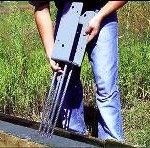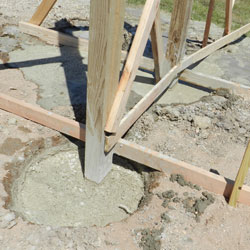Repairing Rotted Lester Building Poles
Reader KEVIN in OELWEIN writes:
“I own a Lester’s (Company name) pole barn machine storage shed on my farm that was built in the late 1970’s. It needs new metal put on the roof. It is 50′ x 80′ with a concrete floor. Some of the poles are rotting just below the soil surface. About 15% of them. So those poles would need to be replaced top to bottom, or perhaps just the bottoms, before doing any other work on the shed. Are there ways for me to replace or repair these rotted pole bottoms on a standing building? I cannot find any contractors who will do the work. Thank you.”
Mike the Pole Barn Guru says:
Sadly, prior to about mid-1980’s, many treatment plants would do what was known as “.60 or refusal” for CCA pressure preservative treating. This resulted in difficult to treat timbers (such as Douglas-Fir) being basically painted green with preservative chemicals, as only minimal penetration would occur. Even with this, many have survived adequately in service for decades.
 Provided column holes were not backfilled with pre-mix concrete (they probably were not), you could temporarily support any given deteriorated column above grade, then cut off the column just above top of concrete slab. From outside, excavate around offending column and remove it. Coat cutoff column bottom end with a waterproof sealant, such as an asphalt emulsion. Place a Sturdi-Wall Plus® wet set bracket on bottom of cutoff upper portion of the column. Clean all loose dirt from bottom of excavation. Use an appropriately sized Sonotube® extending down to at least below frost-line and backfill tube with premix concrete. Backfill around exterior of tube with compactable fill, compacting to at least 95%, no less often than every six inches.
Provided column holes were not backfilled with pre-mix concrete (they probably were not), you could temporarily support any given deteriorated column above grade, then cut off the column just above top of concrete slab. From outside, excavate around offending column and remove it. Coat cutoff column bottom end with a waterproof sealant, such as an asphalt emulsion. Place a Sturdi-Wall Plus® wet set bracket on bottom of cutoff upper portion of the column. Clean all loose dirt from bottom of excavation. Use an appropriately sized Sonotube® extending down to at least below frost-line and backfill tube with premix concrete. Backfill around exterior of tube with compactable fill, compacting to at least 95%, no less often than every six inches.
For a rough idea of required Sonotube® diameter take roof snow and dead loads (should be 30 psf or less) x 50′ span divided by 2 x post spacing (most agricultural Lester Buildings are posts every 10′) to calculate weight to be supported.
Example: 30psf x 50’/2 x 10′ = 7500#
Most soils will support 2000 psf, so 7500# / 2000# = 3.75 square feet (required area of sonotube).
A 24″ sonotube has an area of 3.14 sft, 28″ would give you 4.27 sft.
A Registered Professional Engineer should be retained to verify adequacy of soil bearing capacity, as well as diameter of tube.
For extended reading on Sturdi-Wall Plus® brackets: https://www.hansenpolebuildings.com/2019/05/sturdi-wall-plus-concrete-brackets/
And some thoughts about Sonotubes®: https://www.hansenpolebuildings.com/2013/11/sonotube/








